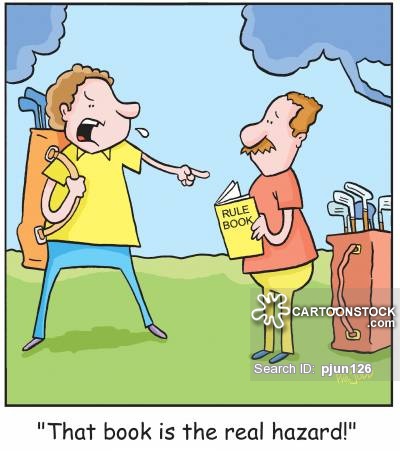A recent discussion within the aptly named Golf Hotel in Crail turned into a lively chat about the rule relating to a lost ball.
Not surprisingly everyone had the own view in what they thought was the appropriate procedure a golfer should adopt in the scenario in question.
However it later led to grabbing a copy of the Rules of Golf to clarify this particular ruling, and then also good friend Alastair McMeekin, with thanks to rules expert Barry Rhodes, providing the answers to the following scenarios involving a lost ball.
Hopefully, the following can help out if you also find yourself in a corner of the local pub and uncertain of the Rules of Golf.
….. Rule 27-1 and Definition of Lost Ball, unless otherwise noted.
Q1: Once a player has declared to a fellow competitor that their ball is lost they may always continue play with a provisional ball that has been played or another ball.
A1: False. If a player’s original ball is found in bounds, within the time permitted following search beginning for it and before another ball has been put into play, the player must continue play with it, no matter what they have said about the ball being lost.Q2: What is the time limit permitted for a player’s side, or their caddies, to search for a ball? a) 4 minutes b) 5 minutes. c) There is no time limit, providing the player does not unduly delay play.
A2: b) 5 minutes.
Q3: If a ball cannot be found and a provisional ball has not been played, the player may drop a ball in the area where the ball is thought to have been lost for a penalty of two strokes.
A3: False. The player must return to where they last played from under penalty of stroke and distance.
Q4: A player drives both their tee shot and a provisional ball into dense trees and they do not find either ball within the permitted search time. How many strokes will they have played when they put another ball into play from the teeing ground?
A4: 5 strokes.
Q5: Time spent in playing a wrong ball is not counted in the time permitted for search. True or False?
A5: True.
Q6: If a player makes a stroke at a provisional ball from a point nearer to the hole (point Y) than where their original ball is likely to be (point X), that ball is in play. True or False?
A6: True.
Q7: A player does not have to search for their ball if they do not want to. True or False?
A7: True. But if their ball is found within 5 minutes of search beginning for it and before they have put another ball in play they must continue with it.
Q8: Which of the following statements is incorrect? a) A player may take relief without penalty for a ball lost in ground under repair. b) A player may take relief without penalty for a ball lost in casual water. c) A player may not take relief without penalty for a ball lost in an obstruction.
A8: c) A player may not take relief without penalty for a ball lost in an obstruction. There is relief without penalty for balls lost in both abnormal ground conditions (Rule 25-1c), and obstructions (Rule 24-2).
Q9: If a player makes a stroke at a substituted ball their original ball is lost. True or False?
A9: True.




